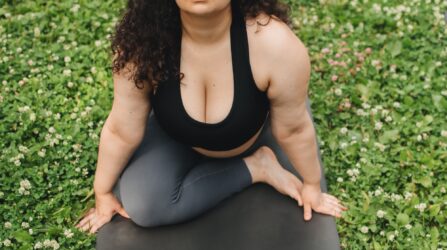
At Hormona, we’re all about women’s health and learning as much as we can about our bodies, our selves and our hormones. And as we often decry, hormones can be an absolutely massive pain in the uterus. From thyroid problems to fertility issues and beyond, they can play havoc with our lives. But, even without those extra hormonal concerns, there’s a monthly hormonal hell that most women experience for many, many decades. Yes, this week, we’re talking PMS. But more specifically, we’re going to introduce you to your prostaglandins and look at why they have such an effect on your 28-day hormonal rollercoaster.
We think it’s crazy that even today the question ‘Is PMS real?’ ranks on Google searches. But rank it does. Why? Well, as you’ll know if you’re a regular Hormona, women’s medicine is sorely lacking in research, treatment and, sadly, basic knowledge. Did you happen to see the editor of esteemed medical journal The Lancet’s recently published views on periods? In his considered professional opinion, menstrual blood is highly poisonous and used exclusively by women to bump off their husbands. So it’s little wonder that some people, we have to say people, but you know who we mean, still don’t believe that we could possibly be suffering. Because clearly, we’re too busy planning the perfect murder.
So for anyone who’s unsure if what they’re experiencing is what we’re talking about, PMS stands for Pre-Menstrual Syndrome. That’s the vague term given to the enormous and highly individual set of symptoms women can, and very often do, experience in the run-up to menstruation. Acne, sore breasts, headaches, bloating, night sweats, mood swings, cramps, sugar cravings, sleepless nights… The list of period side benefits goes on forever. Generally starting around a week prior to the start of bleeding, they disappear almost overnight once your period kicks in. But, around three weeks later, less if you’re really lucky, the rollercoaster starts all over again.
For around 51 percent or so of the population, there’s a very simple answer to the question Is PMS Real? Of course it f*&!£*& is. If you’ve ever lived through even one week of it, you know that hormonal rollercoaster causes havoc in our bodies. But while we generally blame the fluctuating levels of estrogen, progesterone and testosterone for that monthly trip to hell, it seems there may be something else afoot. Yes, those aforementioned hormones play their part. But they’re likely being influenced by something else altogether.
There is, it appears, a hormone-like group of chemical messengers that have an enormous effect on the severity of PMS symptoms. The weird thing, though, is that this group of messengers is involved in and controls a huge number of bodily functions. Welcome to the strange world of prostaglandins.
This group of fatty acids are, believe it or not, incredibly interesting. Prostaglandins are produced in nearly every system, every cell in your body. From your brain and breasts to your gastrointestinal tract and your kidneys, these strange compounds can be found everywhere. They’re also involved in the contraction of your airway and your bowels and even have some influence over your eyes.
For the most part, though, they come into being as a response to injury. Say, for instance, you cut yourself in a bad case of avocado hand. The resulting blood clot and swelling at the injury site come from an increase in prostaglandins. And once the healing process is complete, a reduction in the same prostaglandins sees the swelling, pain, and redness disappear. So, given just how involved prostaglandins are with your entire body, it’s safe to say they’re pretty important.
But this is where prostaglandins get really interesting. In addition to breathing and digesting food – two activities vital to our survival – they’re also involved in our reproductive system. Prostaglandins not only control and regulate our ovarian cycle and periods, they’re crucial to giving birth. Yup, these fatty acids actively decide when a new human comes into the world. And, it seems, they also have some say in menstruation and PMS. Prostaglandins are present in your uterus whether you’re pregnant or not. Which means there’s a very good chance all that period pain is down to them.
Or at least, an imbalance in those fatty acids could possibly increase the severity of PMS symptoms. Prostaglandins are intimately linked to the balance of all the fatty acids in our bodies, and knocking them out of whack can cause issues when that time of the month comes around. You know how we’re always telling you to eat more oily fish? Turns out that it’s more beneficial than even we knew. Not only can a rebalancing of prostaglandins improve and reduce your PMS symptoms, but it can also help you avoid glaucoma and stomach ulcers.
Or, perhaps, rebalance should be a better term. An overabundance of prostaglandins can impact the severity of cramps and the like, but there’s no way you can know for sure which direction you’re headed in without some pretty specialised tests. Fear not, dear readers, because there are some really simple things you can do to help your prostaglandins work out their issues. And at the same time, you’ll feel better and hopefully, your PMS-themed hell will be a little more bearable. First up: That aforementioned oily fish. But if you really can’t do it, a good quality supplement works just as well. As do cutting down on sugar and caffeine, and getting more vitamins. And you know what that means – eating more fruit and veg.
Reducing your alcohol intake wouldn’t hurt. We know, we also love Prosecco cocktails. Moving around some more, particularly around your period, can make a massive difference, both physically and emotionally. And there are even some exercise routines designed specifically to help relieve the symptoms of PMS, including the rather beautifully titled period yoga. Keep records if you can, and keep an eye on the spikes and shifts in your pain levels and symptom severity so you can see what’s actually happening on a monthly basis.
Let us know how you’re getting on and what’s working — you might just help a woman who doesn’t know what else to do!
Disclaimer: This website does not provide medical advice. The information, including but not limited to, text, graphics, images, and other material contained on this website is for informational purposes only. No material on this site is intended to be a substitute for professional medical advice, diagnosis, or treatment. Always seek the advice of your physician or other qualified health care provider with any questions you may have regarding a medical condition or treatment and before undertaking a new health care regimen, and never disregard professional medical advice or delay in seeking it because of something you have read on this website.

-


Dr Singh is the Medical Director of the Indiana Sleep Center. His research and clinical practice focuses on the myriad of sleep.

Understanding the female libido Before we can answer, “Does progesterone increase sex drive?” it’s important to gain a better understanding of what a “sex drive” means. The female libido or sex drive is how much you desire sexual activity. Every

Why am I so hungry before my period? Women who experience an increased appetite before period starts can feel frustrated that they’re craving foods they don’t normally eat. You may be wondering, “Why do I eat so much before my

Understanding cycle syncing workouts Did you know that evidence shows a link between the impact of exercise and menstrual cycle phases in women? It’s true. Women are at a higher risk of foot and ankle injury during workouts than men,
Hormona© 2025, All Rights Reserved
| Cookie | Duration | Description |
|---|---|---|
| cookielawinfo-checkbox-analytics | 11 months | This cookie is set by GDPR Cookie Consent plugin. The cookie is used to store the user consent for the cookies in the category "Analytics". |
| cookielawinfo-checkbox-functional | 11 months | The cookie is set by GDPR cookie consent to record the user consent for the cookies in the category "Functional". |
| cookielawinfo-checkbox-necessary | 11 months | This cookie is set by GDPR Cookie Consent plugin. The cookies is used to store the user consent for the cookies in the category "Necessary". |
| cookielawinfo-checkbox-others | 11 months | This cookie is set by GDPR Cookie Consent plugin. The cookie is used to store the user consent for the cookies in the category "Other. |
| cookielawinfo-checkbox-performance | 11 months | This cookie is set by GDPR Cookie Consent plugin. The cookie is used to store the user consent for the cookies in the category "Performance". |
| viewed_cookie_policy | 11 months | The cookie is set by the GDPR Cookie Consent plugin and is used to store whether or not user has consented to the use of cookies. It does not store any personal data. |
